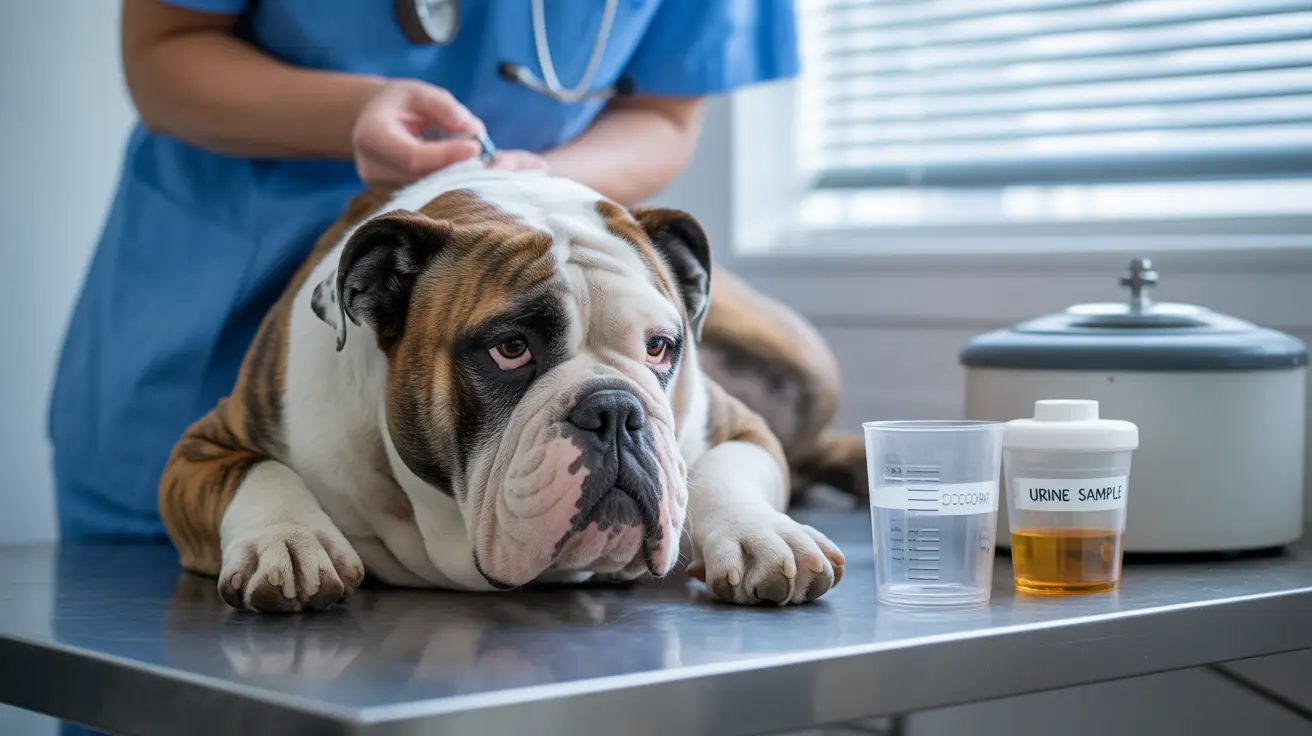Urinary tract infections (UTIs) are a common health concern affecting approximately 14% of dogs during their lifetime. These infections not only cause significant discomfort but can also lead to serious complications if left untreated. Understanding the symptoms, causes, and treatment options for dog urinary tract infections is crucial for every pet owner.
As responsible pet parents, recognizing the early signs of a UTI in dogs can make the difference between a quick recovery and potential complications. With proper knowledge and prompt veterinary care, most canine UTIs can be effectively managed and prevented from recurring.
Understanding UTI Causes and Risk Factors
A dog urinary tract infection typically occurs when bacteria from the skin or rectal area enter the urinary system through the urethra. Female dogs are particularly susceptible due to their shorter urethras, which provide bacteria easier access to the bladder. Certain breeds, including Dalmatians and Bulldogs, face higher risks due to their predisposition to bladder stones and urinary crystals.
Several risk factors can increase the likelihood of UTIs in dogs. Advanced age may bring weakened immune defenses, while chronic conditions like diabetes and Cushing's disease can alter urine composition, making infections more likely. Dogs with compromised immune systems, urinary incontinence, structural abnormalities, or a history of urinary surgery are at higher risk. Additionally, poor hygiene—such as infrequent grooming or unsanitary living spaces—can permit bacteria to thrive and invade the urinary tract.
- Advanced age
- Chronic health conditions (diabetes, Cushing's disease)
- Compromised immune systems
- Urinary incontinence
- Structural abnormalities in the urinary tract
- Previous urinary surgery
- Poor hygiene maintenance
Identifying Dog UTI Symptoms
Early detection of UTI symptoms in dogs is crucial for effective treatment. Common signs can sometimes be subtle, so observing behavioral changes is vital. Your dog may ask to go outside more frequently, have accidents indoors even if previously house-trained, or seem to strain or vocalize in pain during urination. An increase in thirst may indicate the body is trying to flush out the infection, while persistent licking of the genital area often signals discomfort or irritation. Blood in the urine is a serious sign requiring immediate veterinary attention. Lethargy and a decreased appetite may also develop as the infection progresses.
- Frequent urination attempts
- Straining or visible pain while urinating
- Increased indoor accidents
- Excessive thirst
- Persistent licking of the genital area
- Blood in urine (urinating blood dogs)
- Lethargy
- Decreased appetite
Advanced Warning Signs
Some dogs may exhibit more advanced or severe symptoms as the infection progresses. These include vomiting, fever, refusal to eat, significant behavioral changes such as withdrawal or agitation, and clear distress during attempts to urinate. If your dog displays any of these symptoms, seek veterinary care immediately, as they may indicate an ascending infection involving the kidneys or systemic illness.
- Vomiting
- Fever
- Complete loss of appetite
- Significant behavioral changes
- Visible distress during urination attempts
Professional Diagnosis and Treatment
Diagnosing a dog UTI requires a comprehensive veterinary approach. Your veterinarian will start with a physical examination, checking for any pain, abdominal swelling, or other underlying problems. A urinalysis is then performed to detect bacteria, blood, or crystals in the urine. If necessary, a urine culture identifies the specific bacteria involved, which helps determine the most effective antibiotic. Blood tests might be ordered to assess general health and rule out other diseases, while imaging studies—such as ultrasounds or X-rays—may be needed where stones, tumors, or anatomic defects are suspected.
- Physical examination
- Urinalysis
- Urine culture
- Possible blood tests
- Imaging studies when necessary
Treatment Strategies
Treatment for a dog UTI is tailored to the underlying cause and severity of the infection. Most commonly, your vet will prescribe antibiotics specifically targeted at the identified bacteria. Pain management may be necessary if your dog is experiencing discomfort. Increased fluid intake is encouraged, either by providing more water or, in some cases, subcutaneous fluids. Dietary changes may be recommended for dogs with recurrent infections or bladder stones. Follow-up testing is essential to ensure the infection has cleared and to monitor for any return of symptoms.
- Prescribed antibiotics for dog UTI
- Pain management medication
- Increased fluid intake encouragement
- Dietary modifications if needed
- Regular monitoring and follow-up testing
Prevention and Long-term Management
Implementing proper prevention tips can dramatically reduce your dog's risk of UTIs. Maintaining good hygiene—regular grooming and cleaning their living space—can minimize exposure to harmful bacteria. Make sure your dog always has access to fresh, clean water to support urinary tract health and dilute urine. Structured bathroom breaks help ensure that urine does not stagnate in the bladder, which can promote bacterial growth. Tracking changes in urinary habits gives early warnings of potential problems, and routine check-ups with your veterinarian can catch underlying health conditions before they progress. In some cases, your vet might recommend preventive supplements, but these should only be used under veterinary supervision.
- Maintain proper hygiene
- Ensure constant access to fresh water
- Schedule regular bathroom breaks
- Monitor urinary patterns
- Arrange regular veterinary check-ups
- Consider preventive supplements (under veterinary guidance)
Complications of Untreated Infections
Neglecting to treat a dog bladder infection can result in serious, sometimes life-threatening complications. If bacteria migrate from the bladder up to the kidneys, it may cause a kidney infection (pyelonephritis), which can lead to lasting organ damage. Chronic or repeated UTIs can scar the bladder lining, diminish function, or even result in permanent urinary incontinence. In severe cases, bacteria may enter the bloodstream, causing systemic infection or sepsis, which requires emergency intervention. Early diagnosis and treatment are critical for preventing these outcomes and ensuring your dog's long-term well-being.
- Kidney infections (pyelonephritis)
- Permanent kidney damage
- Bladder scarring
- Chronic incontinence
- Systemic infection (sepsis)
Frequently Asked Questions
- What is a urinary tract infection (UTI) in dogs?
- A UTI in dogs is a bacterial infection affecting the urinary tract, bladder, or urethra. It can cause discomfort, changes in urination patterns, and, if severe, impact the kidneys or general health.
- What are common symptoms of a UTI in dogs?
- Symptoms include frequent or urgent attempts to urinate, accidents inside the home, signs of pain during urination, visible blood in the urine, increased thirst, and lethargy.
- How are UTIs in dogs diagnosed?
- Veterinarians use urinalysis to detect signs of infection, culture tests to identify bacteria types, and sometimes blood work or imaging studies to rule out complicating factors.
- What causes urinary tract infections in dogs?
- UTIs are most often caused by bacterial invasion, but underlying conditions like anatomic defects, weakened immune function, or chronic diseases can increase risk.
- How are dog UTIs treated?
- Treatment typically involves a course of antibiotics and may also incorporate pain relief and dietary adjustments to prevent recurrence.
- Can UTIs in dogs become serious?
- Yes. If left untreated, UTIs can progress to kidney infections, systemic illness, or cause permanent organ damage.
- How can I help prevent my dog from getting a UTI?
- Good hygiene, clean water at all times, routine vet check-ups, and prompt attention to urinary changes are key to prevention.
- Are certain breeds more prone to UTIs?
- Yes. Some breeds, such as Dalmatians and Bulldogs, as well as older female dogs, tend to be more susceptible due to anatomy or predisposition to urinary stones.
- Can a dog's diet impact UTI risk?
- A balanced diet that maintains optimal health and encourages good hydration lessens UTI risk by helping flush out bacteria.
- When should I see a vet about my dog's urinary issues?
- Consult your veterinarian any time you observe symptoms of infection, pain, or changes in your dog's urination habits to ensure timely and effective treatment.
Understanding and properly managing urinary tract infections in dogs is essential for maintaining your pet's health and well-being. By staying vigilant for symptoms, seeking prompt veterinary care, and following prevention guidelines, you can help protect your furry friend from the discomfort and potential complications of UTIs. Remember that early intervention is always the best approach when dealing with dog urinary issues.






